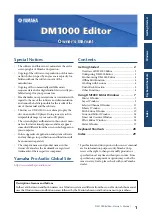
Media Flow Controller Overview
Media Flow Controller Administrator’s Guide
42
Management Interfaces Overview
Copyright © 2010, Juniper Networks, Inc.
Command Line Interface (CLI)
You can log in to the Media Flow Controller server via the command line interface (CLI) by
invoking a SSH session. The CLI allows all aspects of system configuration and management.
Web Interface (Management Console)
You can log in to the Media Flow Controller Web interface, also referred to as the
Management Console, from a Web browser using HTTP and port 8080 (for example, http://
Media Flow Controller-Hostname:8080/). HTTPS can also be used if SSH certificates are set
up properly. The Web interface makes it easy to configure and manage the system from any
remote location. The Web interface provides a powerful dashboard that displays real-time
performance data such as number of concurrent connections, cache-hit ration, bandwidth
served, and CPU/memory/disk utilization.
SNMP Interface to Network Management System
The Simple Network Management Protocol (SNMP) is used by network management systems
(NMS) to communicate with properly configured network elements. Media Flow Controller can
be integrated with 3rd party network management systems via its built-in SNMP agent. The
Media Flow Controller SNMP agent provides the following functions:
•
Supports SNMP MIBs that can be queried to retrieve system status, and system counters
•
Generates SNMPv2 traps in case of system failures, that can be sent to higher-level
network management systems
SNMP Messages (TRAPs, GETs, and SETs)
SNMP messages may be initiated by either the network management system (NMS) or by the
Media Flow Controller. An SNMP TRAP is a message initiated by a Media Flow Controller and
sent to the NMS; for example, a message that one of its redundant power supplies failed. An
SNMP GET is a message initiated by the NMS when it wants to retrieve some data from a
network element; for example, the network management system might query a Media Flow
Controller for the utilization on a WAN link every 5 minutes. It could then create graphs from
that data, or warn the administrator when the link was overutilized. An SNMP SET is a
message initiated by the NMS when it wants to change data on a network element (for
example, alter a static route); in Release 2.0.4 Media Flow Controller does not support SNMP
SET.
The SNMP MIB
The SNMP MIB, or Management Information Base, is a collection of variables shared between
the NMS and the Media Flow Controller. See
Chapter 11, “Media Flow Controller MIB
Definitions”
for details.
SNMP Community Strings
The most basic form of SNMP security is the Community String. SNMP Community Strings
are like passwords for network elements. Most often, there is one community string which is
used for read-only (ro) access to a Media Flow Controller. The default value for this
community string is public. Using this community string like a password, the NMS can retrieve
data from Media Flow Controllers. In Release 2.0.4 only SNMP ro (Read-Only) is supported.
Содержание MEDIA FLOW CONTROLLER 2.0.4 -
Страница 6: ...Media Flow Controller Administrator s Guide VI Copyright 2010 Juniper Networks Inc...
Страница 24: ...LIST OF FIGURES XXIV Copyright 2010 Juniper Networks Inc...
Страница 37: ...Copyright 2010 Juniper Networks Inc 37 PART 1 Media Flow Controller Administration...
Страница 38: ...Media Flow Controller Administrator s Guide 38 Copyright 2010 Juniper Networks Inc...
Страница 285: ...Copyright 2010 Juniper Networks Inc 285 PART 2 Media Flow Controller Command and MIB Reference...
Страница 286: ...Media Flow Controller Administrator s Guide 286 Copyright 2010 Juniper Networks Inc...
















































